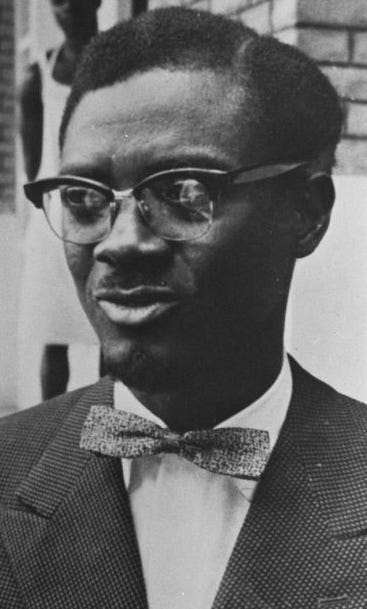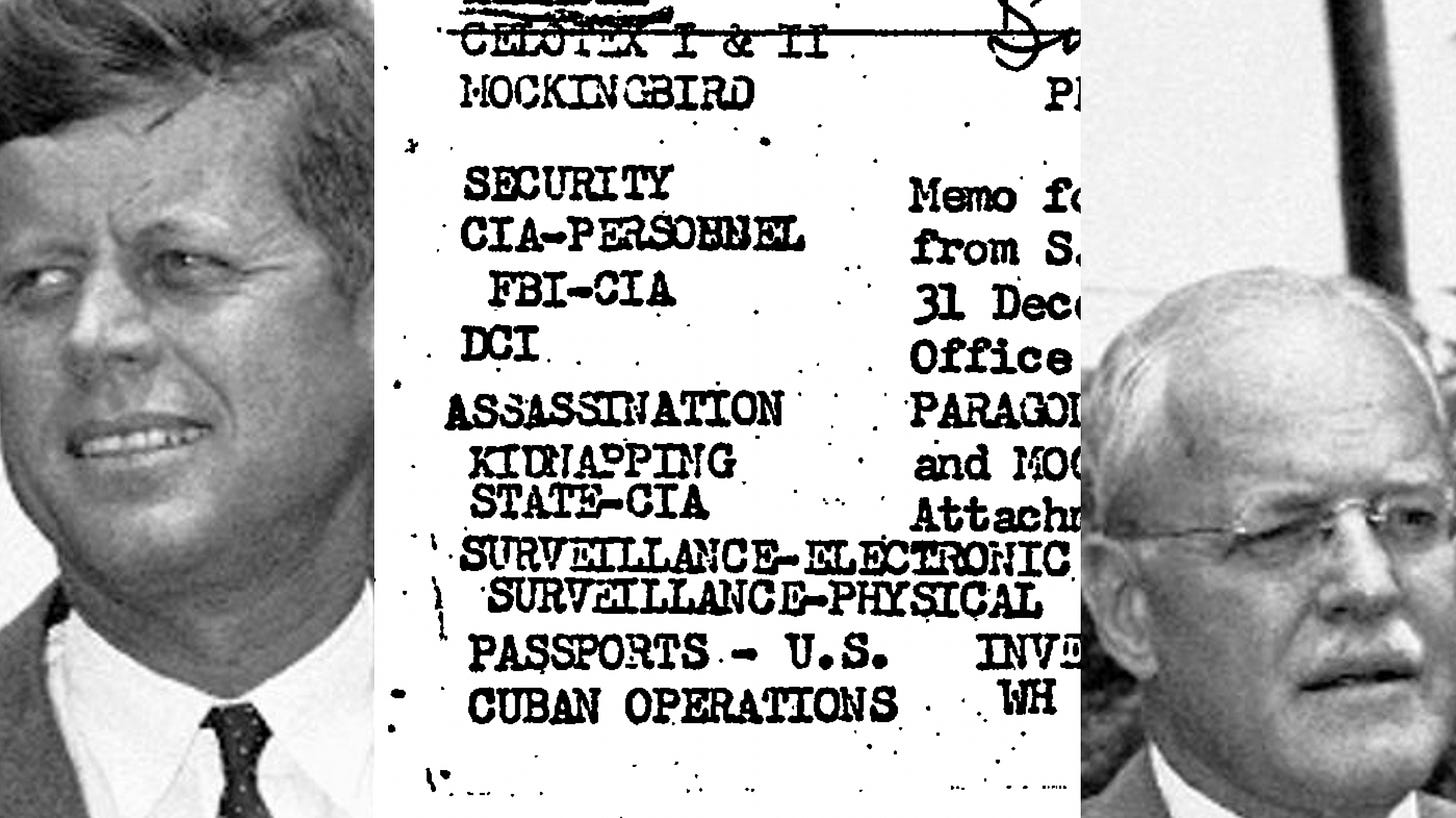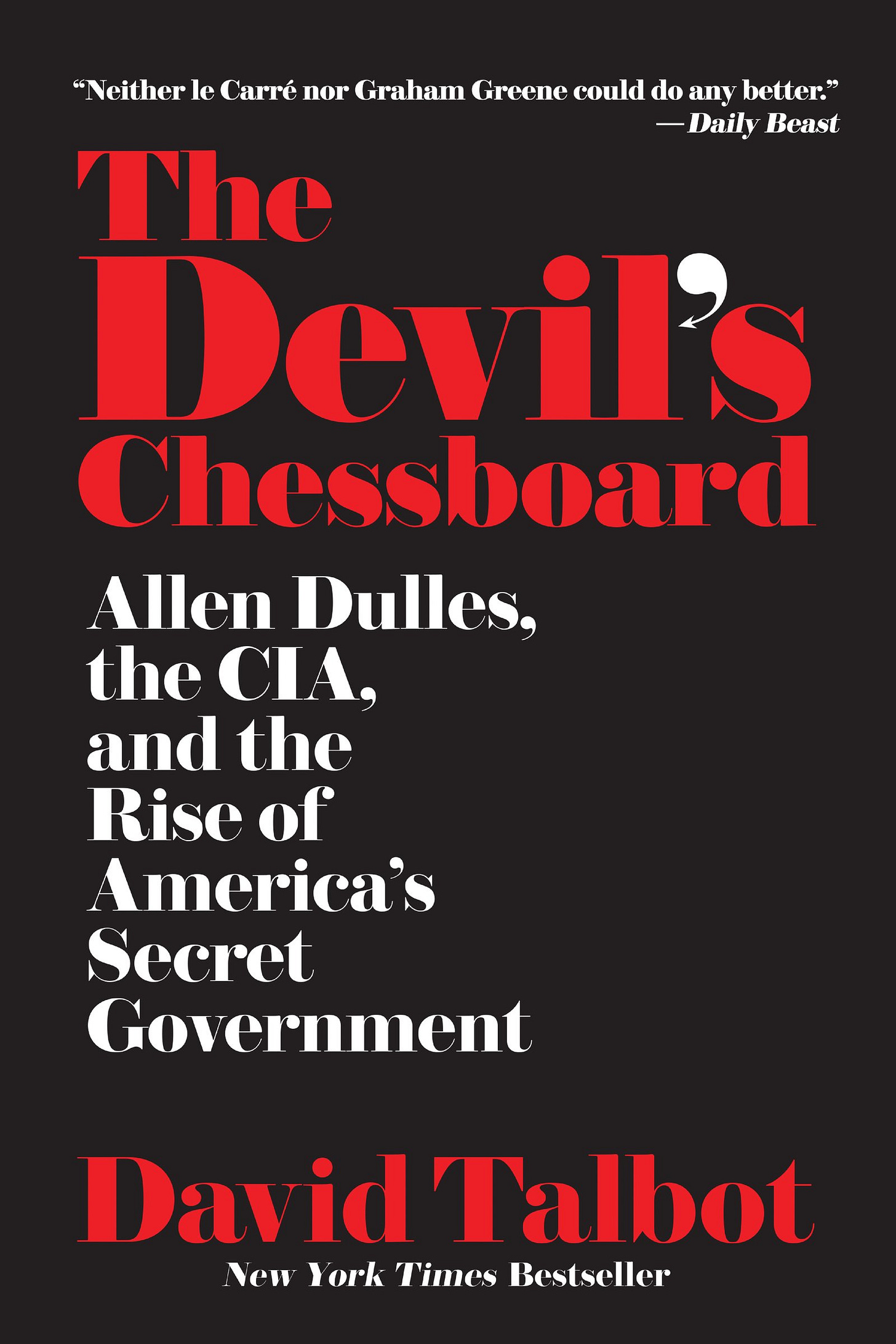The first part of my forthcoming book High and Mighty explores how people in power have consumed drugs through history. The second half examines how the same people have controlled or manipulated others’ drug use. The notes I’ve shared so far have focused primarily on ancient history, so today I wanted to change it up a bit and share some material from the not-so-distant past concerning drug use by the powerful.
With the recent release of another batch of JFK documents, there has been some buzz about the former president as well as the notorious federal agency that feuded with him—that is, the CIA. Therefore I felt it would be appropriate to check out the drugs of choice among JFK and the spooks at the upper echelons of the CIA who were known for their dislike of the young, progressive head of state (a head in more ways than one).
I’ll devote a post to JFK’s drug use soon, but for now, let’s take a look at how Allen Dulles, the longest serving director of the CIA who headed the agency until Kennedy fired him, liked to get his dopamine. We’ll also look at some of the other powerful people around Dulles (and Kennedy) and how they all got down together.
Getting sloshed with Nazis
Readers may or may not already be aware that Allen Dulles was personally acquainted with Hitler and numerous other top Nazi officials as part of his work with the law firm Sullivan and Cromwell.1 And of course, Hitler and his top brass were totally loaded on a slew of substances, which I will also cover in an upcoming post.
As World War 2 came to an end, Dulles helped an extraordinary number of Nazi officials flee from Germany and evade accountability for the atrocities they committed during and before the war. Perhaps not surprisingly, Dulles and the Nazis shared drugs together over the course of this years-long collaboration—namely, alcohol. For example, when Dulles met with Heinrich Himmler, who led Hitler’s SS unit, the two of them enjoyed Scotch by a fireplace as Dulles assured Himmler that he would not face punishment for his role in the Nazi regime.2
Pictured above left, Heinrich Himmler. On right, Allen Dulles. In center, a fireplace and some Scotch. You get the idea.
Another SS official who escaped persecution thanks to Dulles’s conniving was Eugen Dollmann. Dollmann fled from Germany to Italy, where he spent a brief respite at a drug rehab facility for wealthy clients. Among the other clients there was an Italian movie star who had managed to smuggle some heroin into the facility. At one point Dollmann helped himself to a hearty dose from her stash, choosing to self-administer via insufflation (i.e. to snort it).3
Yet another notorious German who collaborated extensively with Dulles was Reinhard Gehlen, the Nazi thug who provided security services for the US military in Berlin after the war. When Gehlen visited the US, he came to see his pal Dulles, who would then take the war criminal to his preferred private clubs for the elite scattered throughout Washington and the surrounding area [such as the Metropolitan Club and the Chevy Chase Club]. There, they drank and dined together, sometimes accompanied by their wives.4
Wine, Yachts, and Coup D’états
Dulles didn’t just drink when he hung out with Nazis. He imbibed regularly. It seems that his favorite drinks were Scotch and expensive European wine. He also smoked quite a bit of pipe tobacco (as seen in numerous pictures of the old spymaster). As anyone with personal experience will know, sufficient quantities of alcohol and tobacco can get one pretty fucked up, or, to use a more pleasant term, high. Judging by the sheer frequency with which Dulles consumed alcohol and tobacco, we can safely say that his mind was enriched with psychoactive effervescence from his substances of choice.
But then again, a stunningly large number of government officials—then and now—have performed their duties while buzzed on alcohol and between puffs of tobacco. This should come as no surprise.
Indeed, liquor was ubiquitous in the circles in which Dulles made vital decisions that would shape the world for decades to come. Long before Kennedy took office, alcohol was an active ingredient in discussions among United States presidents and their top officials. As journalist David Talbot wrote, “the Eisenhower administration’s increasingly militant policy toward [the democratically elected leader of the Congo, Patrice] Lumumba took shape over cocktails” sipped leisurely in the conference rooms of various East Coast think tanks.5
Patrice Lumumba.
Central in such discussions was William Burden, an heir to the Vanderbilt fortune who had donated a large sum to Eisenhower’s presidential campaign. Burden was then rewarded accordingly with a position in the administration when he became the US ambassador to Belgium, the country that had wrought utter havoc upon the Congo in their colonization of the central African nation. A FOIA request later revealed that during his time as ambassador, Burden corresponded with Allen Dulles to discuss the potential use of chemical weapons on civilians in the Congo as a means to quash backlash to US intervention in the country. The individuals who, not long thereafter, carried out the brutal torture and execution of Lumumba were found to have been affiliated with Dulles’s agency. And Burden, like Dulles, liked to imbibe. He was, in the Talbot’s words, a “high-society boozer.”6
There was another ultra-wealthy figure in Dulles’s network who bore a particularly interesting connection to both him and Kennedy. Charlie Wrightsman was an oil tycoon with a penchant for luxury who was a client of Dulles’s at the above-mentioned Sullivan and Cromwell law firm. The flush Wrightsman often invited Dulles to join in his elite lifestyle, and Dulles (who himself was not particularly wealthy but who surrounded himself with disgustingly rich individuals) gladly accepted.
Wrightsman treated Dulles to sessions in his private, heated pool, complete with warmed towels waiting for the guests. He also took Dulles on yacht cruises through the Mediterranean. And, to the apparent disdain of Dulles’s wife Clover, Wrightsman is the one who first sparked and then nurtured Dulles’s taste for expensive wine.7
Interestingly, it is also through Wrightsman that Allen Dulles first met a young John F. Kennedy in the mid-1950s. It would prove to be the start of a troubled and contentious relationship marked by drama and struggle. On at least one occasion, Wrightsman managed to have Kennedy, Allen Dulles and his brother John Foster all over for dinner. Unfortunately, I don’t know what they drank that night. Perhaps a vintage Bordeaux from Wrightsman’s stash?
Charles Wrightsman, Dulles’s wealthy drinking and smoking buddy.
Another wealthy vinophile who hung out with Dulles was C. D. Dillon. Originally a Wall Street banker, Dillon then shifted into the upper strata of the federal government, first as John Foster Dulles’s Under Secretary of the State Department in the Eisenhower administration. When Kennedy was elected, Dillon was tapped as the Secretary of the Treasury, a role he held through the subsequent Johnson administration.
Dillon’s family had financial interests in the Congo, and as such he played a key role in the US intervention after Lumumba’s election there. Dillon’s family also owned vineyards in France, where they hosted Allen Dulles. There, the scheming saboteur spent several days, in his own words, “renewing my acquaintance with my favorite wines from the Bordeaux country.”8 The old spook counted his time at the Dillons’ Château Haut-Brion among his favorite memories in life.
But Dulles needed something a bit stronger on April 17, 1961 when a CIA-organized mercenary army tried and failed to invade Cuba at the Bay of Pigs. Earlier that day, Dulles had given a talk at an “oceanfront luxury hotel” in San Juan, Puerto Rico.9 But by nightfall he was back in Washington. He had stopped at an airport in Baltimore, Maryland en route, where he was greeted by the chief of operations for the Bay of Pigs project, Richard Drain.
Fidel Castro was the Prime Minister of Cuba during the Bay of Pigs invasion.
Drain, a Skull and Bones member and proud of his work for the CIA, had been told to pick up Dulles at the airport and see him safely to Washington. The two of them drove Dulles’s Cadillac from Baltimore back to DC. On the ride, Drain updated Dulles on the quickly deteriorating operation which by then seemed certain to fail. Dulles packed a pipeful of tobacco and smoked somberly as Drain provided the disappointing briefing.10
When they arrived at Dulles’s home in Georgetown, the director invited his underling inside. But he did not want to discuss the unfolding fiasco—he wanted to drink. He brought out his old favorite, Scotch, and promptly served himself and his guest. Buzzing on nicotine and sipping liquor, Dulles asked Drain some questions about an unrelated matter he needed to tend to the following day. Drain was struck by the notable lack of interest from Dulles in the Bay of Pigs issue.
Drain, the DC point man for the Bay of Pigs operation, was quite worried about the situation and had expected Dulles to take active interest in trying somehow to recoup the effort. But Dulles just wanted to smoke and drink. Talbot speculates whether Dulles’s nonchalant nature that day was some sort of calculated move.11 But I see something else: a habitual drug user who needed his preferred dose(s) before he could properly tend to his professional obligations.
In what would become a defining moment in his career, a catastrophic failure for his agency and for US hegemony more broadly, the legendary CIA director—undoubtedly under great stress despite his cool exterior—resorted to the reliable comfort of his beloved Scotch and a pipeful (or two) of tobacco. He could never take down Castro, but he could certainly take down his liquor.
In conclusion…
Dulles was, in his own way, a druggie, though he notably stuck to substances which were and are legal: pipe tobacco, nice wine, and Scotch. He took these drugs regularly and during some of the most dramatic and important points in his long, storied career. As such, we are apt to recognize the small role played by these substances in the series of decisions made by Dulles and his cronies that shaped the geopolitical climate for years to come.
Soon I’ll share my notes on the drug habits of Hitler and his inner circle as well as John F. Kennedy, both of whom had hefty appetites for psychoactive substances of all sorts.
The above information comes from The Devil’s Chessboard: Allen Dulles, the CIA, and the Rise of America’s Secret Government (2015) by David Talbot, the founder of Salon. The book is essentially a biography of Dulles and examines, among other things, Dulles’s troubled relationship with JFK as well as his impact on not only the US but the world. Talbot manages to pack an unfathomable amount of information into a page-turner that reads like a spy novel. Highly recommended.
Talbot,The Devil’s Chessboard, 20
Ibid., 30
Ibid., 94-95
Ibid., 275
Ibid., 377-378
Ibid., 378.
Ibid., 358-359
Ibid., 551
Ibid., 393
Ibid., 394
Ibid., 395-396











